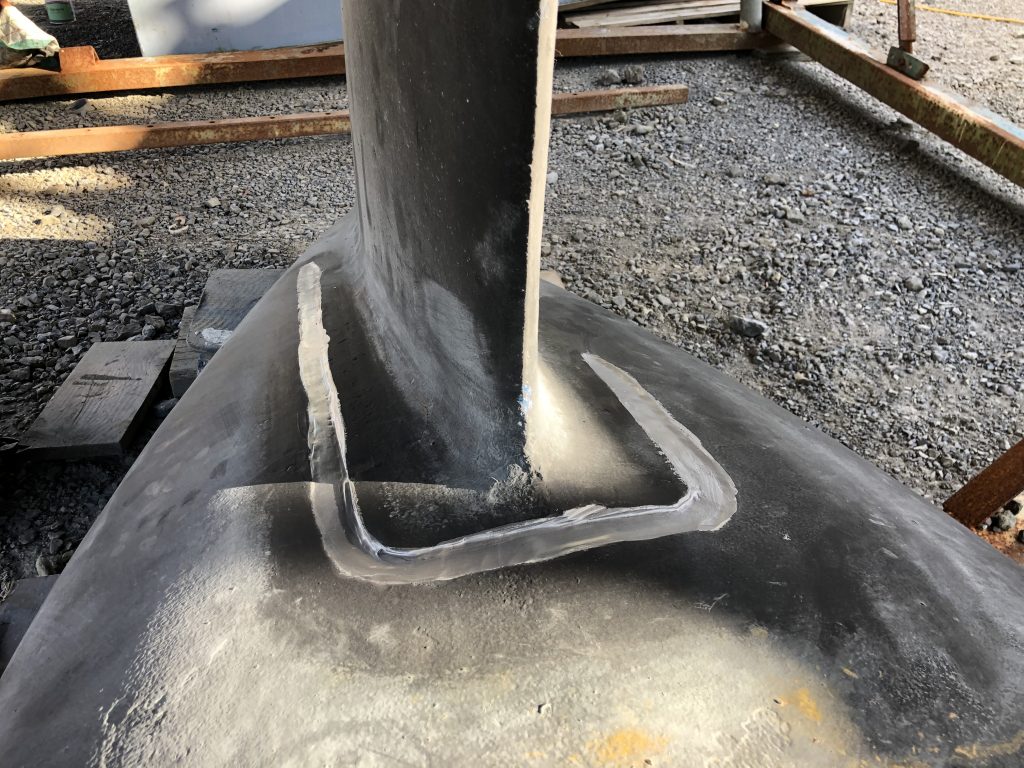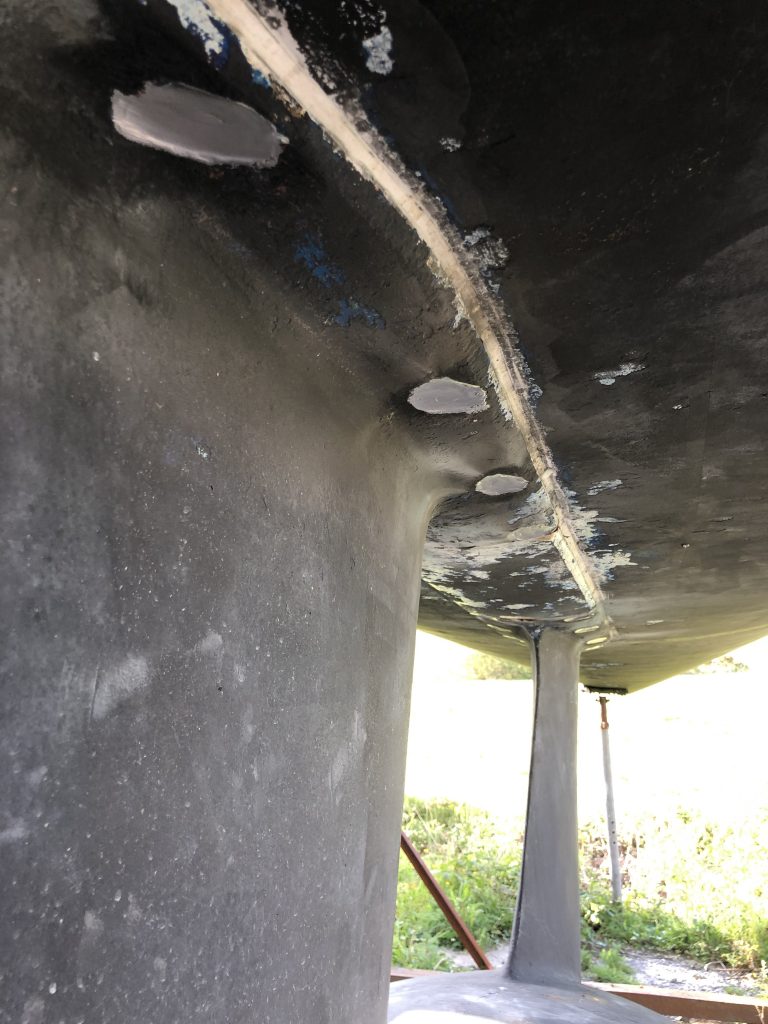It has been a few days since the last update, and I did leave you hanging on a low note, didn’t I?
Well, no need to worry really, I’m back and working as usual. It has been a little frustrating that the weather doesn’t really seem to take off, but I have no say in that. So I need to focus what I can control, and that is how I react to it and events around me.
I’ve been running around with the grinder and grinding off even more oxidation from the helm station backingplate, to the extent that I finally thought it was enough and slapped on three layers of primer on it. So, now it is looking like silver! There is quite a lot of pitting and not all the pits were possible to clean out so this is probably a fix that I will have to come back to some day, most likely by replacing it. But it is done! So sweet to put that one behind me.

But that isn’t the only thing that I’ve been grinding on, I also gave the keel a bit of a work too. The reason is that it was a thin line of corrosion that followed the “wing” of the keel all the way around the bulb, and on starboard side there was a rather large spot of rust and moisture that was a concern. so what to do? Grind it down and try to figure out what was going on, of course! There were some layers of paint, but also fairing compound, on the bulb and while i ground it away I saw a thin line, a crack, where there was oxidation all the way down to bare metal. One thing i didn’t expect was the thickness of the layer of fairing compound and another thing I didn’t expect was that it wasn’t even. The inner side of the crack seemed to be lower than the outer and since I already had ground of enough for me to be hesitant to go any deeper I chose to stop there. I followed the crack around the keel and when it was all removed I put on three layers of primer, ready to be faired so it won’t be noticeable that I was there with my grinder.
But when I was done I did take a look at the front of the keel and it looks like it really should have the same treatment to be fair. But it is a quite large area and I’m not that keen on opening up that can of worms, really. But we’ll see. If I know myself enough something tells me I will do it, unless adviced otherwise.

Another thing that I put the grinder to is the keel bolts! Oh, yes. You thought they were done, didn’t you? Nope. They are done on the inside of the boat, now comes the last piece. Making sure they aren’t in contact with air or water on the out side. Some actually looked a bit rusty already, nothing severe of course, so they do need a good protection for sure.
So, lying on my back, grinding off up to 10 mm of the protruding bolts so that they were below the paint was what I had to do. Sixteen times. Pushing a grinder weighing 3kgs against the keel on almost straight arms. It was a work-out and it took its time, but it was really rewarding when they were done. I managed to film most of it too, even if batteries was depleted to left and right constantly.

I wiped them all down and then put on primer on them as well, like I’ve done with the rest before. And you know, even if it might move slowly it is getting me there, eventually. My plan is to get some fairing compound tomorrow and fair them so that I can sand all down to be ready for paint at the end of the week.
I had to go to town after all this grinding, so I got out of my overall and was about to jump into the car when I looked into the mirror…

A quick wash was called for, then I headed to town!
I’ve also been doing some digital work. I’ve been wrestling with my old installation of OpenPlotter, a free and open software that is a substitute for using an expensive plotter when navigating. Mainly I’ve been trying to upgrade it to the latest version, since the installation I had was 1.0.0 and the latest is 2.3.0. It hasn’t been cooperating, so I will most likely reinstall the whole shebang later on. Right now my patience with it is short. While I’ve been doing that I’ve also tried to make it an access point for my internal network, but it just wouldn’t cooperate there either. Linux is definitely not my area of expertise and I’m jumping in at the deep end for sure. I gave up eventually and started to look for a mobile access point instead, and found one that I felt was reasonably competent and possibly a good investment for the future, since it can be used on the go, thus can many devices share the one data connection, which can be useful.

The reason why I was trying to get a working local area network on the boat is that I’ve been having a lab-day with one of my arduinos, connecting the flow meter that I bought some weeks ago, it was probably over a month ago when I think of it.
It. Was. So. Much. Fun!
Finally I had some success with these small computers. It is actually not an arduino, but rather a WeMos D1 mini clone. But who can type that all the time? And they share the same development environment as well as the command set, hence “arduino”.
The program itself is rather simple, as most usually are on these small computers, since they themselves are simple in every way possible, including speed and memory. First finding an example of code that counts pulses, then some code running with this specific flow meter to measure volume and then some code on how to connect to the boats network and finally some code to call a website with the number of pulses that had passed.
Then I jury-rigged a funnel on top of it and tried to estimate the volume that passed for every pulse. Depending on source it seems to be somewhere between 2.25 and 2.5ml per pulse. I measured it to 2.4, but since it was a funnel and some air could have come in and the paddlewheel probably spun a few extra turn as it slowed down I’d guess 2.5ml can be accurate that I found in a data sheet from the manufacturer. I also set up a test website to receive the result, and it seems to work! All very simple at the moment, just validating my theories and make sure I can do what I want to do with them.
So, why?
Well, it is nice to know how many “pulses” each tank can hold when they are filled up, so that I can see if I got 10, 20 or 50 percent left in each tank. This is of course no exact science, but it is much better than the gauge on each tank that is even hard to guess if it is full or empty. Another feature is that I can collect some metrics, so that I can predict how long the water might last, depending on current usage. And graphs! Oh, yes, graphs! My main issue is that it is harder to measure when filling the tanks, since the inlet is rather large and there is no way to guarantee that the flow is enough to fill the hose and thus I don’t know if a turn of the paddel wheel is full with water or free-spinning as the water just stopped. Same issue that I had with the funnel. Therefore the dice. I used it to stop the vortex to build up and draw down air into the flow meter to get more predictable and correct values.
I forgot to mention that I have replaced the ball joint on the steering rod as well, but that’s for another day. It’s time to wrap this up, the post is long as it is.
As a finale on this post I just want to share a short piece of the road I drive to get to the town. It is amazing.

A possible solution for your water tank problem is to measure level rather than flow. For instance using radar. This will get you very high precision.
https://www.digikey.se/product-detail/en/acconeer-ab/XM122/1891-XM122-ND/10447766